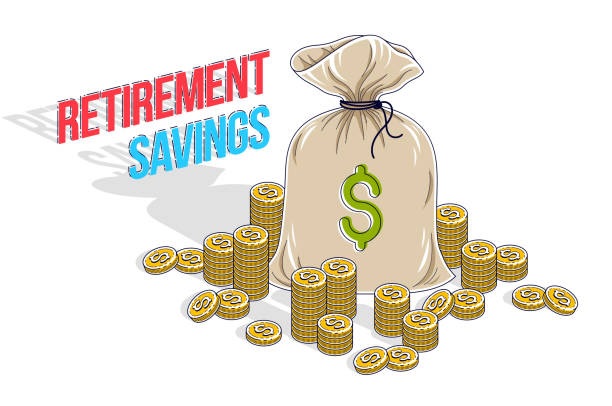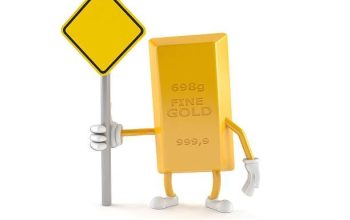There’s never been a better moment in history to start investing in gold. Inflation is rising, the U.S. dollar continues to fall, and interest rates are expected to rise further. With those factors in mind, it makes sense to consider adding gold to your portfolio.
A gold IRA is a great way to do just that. An IRA allows you to save money tax-free and grow it over time without having to pay taxes on it. You can even withdraw the funds later to purchase gold coins and bullion.
Gold is an excellent hedge against future inflation because it cannot be devalued like fiat currencies. Plus, gold is one of the few investments that holds its value better during times of economic turmoil. Because gold prices tend to move together, owning physical gold gives investors protection against the risk of currency debasement.
What does a gold IRA account entail?

A gold IRA is an account that allows you to invest in physical gold or other precious metal assets. This type of investment is commonly known as a ‘physical’ IRA because it involves buying actual bullion rather than stocks or bonds.
Investors choose whether to invest in gold or another precious metal such as silver, platinum, or palladium. Each precious metal offers different benefits. For example, gold tends to be less volatile than other investments, while silver tends to rise during times of economic uncertainty. Platinum and palladium tend to fluctuate together since they both represent rarer forms of the element.
The advantage of investing in a gold IRA is that you can access your money whenever you want without having to sell anything. You simply withdraw cash from the account, either directly or through check writing. If you decide to take out some of your funds, you can use them to purchase something else – like a house or car.
You don’t have to worry about taxes either. Unlike traditional retirement accounts, there are no income tax penalties for withdrawing funds early. Your earnings are taxed just like regular income.
The pros and cons of gold IRA

The gold market is one of the most volatile markets out there. Investors often look to precious metals like gold and silver as a hedge against inflation and economic uncertainty. But while it’s true that gold and silver tend to move up during times of turmoil, they can also go down too. If you don’t know what to do with your money, consider opening a gold IRA.
There are many advantages to owning gold in retirement. For starters, gold tends to increase in value over time. This makes it a great way to preserve wealth over the long term. Plus, you won’t find better returns than those offered by a traditional IRA. In fact, some investors report seeing annual returns of 10% or more. You’ll also avoid taxes on capital gains and dividends. And if you decide to sell your gold, you can do so without paying tax — just pay income tax on the gain.
However, there are drawbacks to investing in gold. First off, it doesn’t always perform well in turbulent financial markets. While gold prices tend to rise in bearish environments, they can fall too. Also, the price of gold fluctuates frequently. So, if you invest in gold and the price drops, you could lose money. Finally, gold isn’t liquid. This means you can’t easily convert your holdings into cash.
If you’d prefer to diversify away from stocks and bonds, a precious metal IRA might be a good option for you. However, it’s important to understand exactly how much risk you’re taking. A gold IRA is different from a regular IRA because it allows you to buy physical bullion rather than shares of stock. Physical gold is more stable than paper currency, making it less likely to drop in value. On the flip side, though, it’s harder to turn around and sell if you want to take advantage of short-term opportunities.
You can open a precious metal IRA with either Fidelity Investments or Schwab. Both offer low fees and easy access to funds. They both charge $6 per month for administrative costs. You can use your existing brokerage account to make deposits and withdrawals.
Gold IRA pros
The biggest advantage of investing in gold and silver is having access to it whenever needed. Unlike stocks and bonds, there are no dividends paid out to investors. So, if you want to invest in precious metals, you must buy them yourself. If you decide to go down this road, you will need to open up a self-directed retirement account such as a 401(k), Individual Retirement Account (IRA), or Roth IRA. You can choose whether you want to invest in physical gold or paper certificates.
If you opt for physical gold, you will need to find someone to store it for you. This person could be a bank, a jewelry store, or even another investor. To make sure you don’t lose your investment, you must keep track of where your coins are stored. Most people use online tracking software to do this.
If you prefer paper certificates, you won’t need to worry about storing them because the government keeps track of them. However, you will still need to pay taxes on your gains. In addition, you will need to report your holdings every year.
Another benefit of owning physical gold is that it protects you against inflation and market risks. As long as you hold onto your metal, you will always be able to sell it at a fair price. And since it doesn’t fluctuate like most assets, you will never lose value.
It provides greater control over your future
The gold IRA is one of the most popular retirement accounts because it allows investors to diversify their portfolios while protecting their assets during times of economic uncertainty. A gold IRA offers greater control over your future than a traditional IRA because it gives you the ability to invest in physical gold bars rather than stocks or bonds. This type of account is ideal for those looking to protect themselves from inflationary pressures.
A gold IRA is similar to a regular IRA except it invests in precious metals such as gold and silver. You can open up a gold IRA with just about any brokerage firm, including Fidelity Investments. Once you decide what kind of metal you want to invest in, you can start building your portfolio. As long as you keep adding money each month, you can continue investing in your gold IRA even if you are no longer working.
You can choose to take out your earnings in cash or reinvest them into another asset class like stocks or bonds. If you choose to withdraw your earnings, make sure you do it gradually so you don’t trigger a 10% early withdrawal penalty.
If you plan on taking withdrawals from your gold IRA, you’ll likely pay taxes on the amount withdrawn. However, there are some exceptions to this rule. For example, you won’t owe capital gains tax if you’re withdrawing funds from your gold IRA to buy a home.
It provides your portfolio with a powerful hedge
Investors looking for a way to protect themselves against stock market volatility might want to consider gold. While precious metals like silver and platinum are often thought of as commodities, gold is actually considered a strategic asset because it provides investors with a powerful hedge against stock market volatility, according to a recent study by Morningstar.
The report found that over the long term, gold outperforms both the S&P 500 Index and the Dow Jones Industrial Average. In fact, during the 10-year period studied, gold outperformed the S&P 500 by 2.4 percentage points per annum, compared to just 0.2 percentage points per annum for the Dow.
While gold does provide investors with some protection against stock market volatility, it doesn’t offer much protection against inflation. However, gold is still considered a good investment because it tends to perform better than most other investments during periods of economic uncertainty.
Another benefit of investing in gold is that you don’t need to worry about taxes. Unlike stocks and bonds, gold isn’t subject to capital gains tax, dividend tax, income tax, estate tax, or gift tax.
In addition to providing investors with a strong hedge against stock market volatility and protecting them from taxation, gold is also a smart choice for retirement portfolios. Because gold is relatively stable, it’s generally regarded as a safe haven asset. This makes it a good option for retirees who are concerned about the potential loss of purchasing power due to inflation.
It is the ultimate disaster insurance for your portfolio
If you want to protect yourself from inflation, gold is one of the best investments out there. But what about protecting your retirement savings from currency fluctuations? If you don’t already have an IRA, now might be the perfect time to open one up. You’ll be able to take advantage of some of the most favorable terms around.
Gold IRA Cons
The gold market is booming again. But it’s not just because of the US dollar’s recent weakness. Investors are flocking to precious metals like never before. And one investment option that’s been gaining popularity lately is a type of retirement account known as an Individual Retirement Account (IRA). These accounts allow you to invest in physical assets such as stocks, bonds, real estate, commodities, and even bullion. You can use them to save money for college tuition, pay off debt, fund a home purchase or simply stash away some cash for retirement.
But there’s a big difference between investing in traditional stock and bond mutual funds and putting your hard-earned dollars into physical metal. When you put your money into a gold IRA, you’re taking a risk. Unlike most investments, physical gold doesn’t generate dividends. So, unlike a regular savings account, you won’t earn interest on your gold. Plus, you don’t know where your gold is stored. If something happens to your house, your car or your jewelry, you could lose access to your gold.
With a gold IRA, however, you’ll receive tax breaks. This is because the IRS considers gold to be a collectible item. As long as you keep your gold in a safe place, you can deduct the value of your holdings against your income taxes. In fact, you can claim up to $10,000 per person as a deduction. For those who qualify, a gold IRA could offer better returns than a regular brokerage account.
You might think that buying physical gold is too risky. After all, prices can fluctuate wildly. However, experts say that owning gold isn’t nearly as dangerous as many people believe. They argue that the price of gold tends to rise over time, making it a good way to preserve wealth. Plus, you can diversify your portfolio by adding other types of investments.
Of course, there are downsides to owning gold. First, you must make sure that you’ve got enough space to store your coins. Second, you’ll need to worry about storage costs. Third, you’ll have to deal with the hassle of finding a trustworthy dealer. But if you want to take advantage of the benefits offered by a gold IRA, you should consider opening one today.
Most account administrators won’t let you physically store your gold holdings
Most IRA administrators will not allow you to physically store your gold holdings within your account. This is because it could lead to theft or loss. If you do want to keep some of your gold in a safe place, there are several options. One option is to use a third-party custodian. Another option is to use a self-directed IRA. Self-directed IRAs are very secure because they give you full control over how much money you want to invest in precious metals.
Gold IRA accounts are long-term investments and not quick profit opportunities
Investors seeking long-term stability should look into investing in gold exchange-traded funds (ETFs). These products allow investors to gain exposure to physical gold without having to worry about storing it themselves. A recent study found that gold ETFs outperformed traditional mutual funds during the financial crisis.
The study, conducted by Morningstar, looked at the performance of gold ETFs versus traditional mutual funds from January 2007 to December 2009. During this period, gold prices rose from $821 per ounce to nearly $1,900 per ounce. In contrast, traditional mutual fund returns fell from 10.5% to -4.3%. This meant that gold ETFs returned almost twice as much money as traditional mutual funds.
Physical gold is still the best investment vehicle for those concerned about future inflation. As the price of gold rises, the purchasing power of your holdings increases. If you invest in physical gold today, it could provide you with a steady stream of income for decades to come.
It does not pay dividends or interests
Investors looking for a way to generate passive income may want to consider investing in physical gold. But it turns out that investing in gold doesn’t actually make you rich. In fact, it might cost you money.
The reason why investors are drawn to gold is that it holds value over time. If you buy $1,000 worth of gold today, that same amount of gold will be worth $1,100 next year. This makes gold a great investment for long-term growth.
But while gold does hold value, it doesn’t offer dividends or interest payments. And unlike stocks, bonds, or even cash savings accounts, there isn’t much you can do with gold once you’ve purchased it. You can’t sell it, borrow against it, or use it as collateral.
So if you’re thinking about buying gold as an investment, don’t expect to make money off of it. Instead, think of it as a safe haven asset — something that could potentially help protect your wealth during times of economic uncertainty.
How can I invest in a gold IRA?
Investing in gold isn’t just about owning it. You can also use a gold IRA to diversify your investments. This type of retirement account allows you to contribute money to buy physical gold bars or coins. With a traditional IRA, you’ll pay taxes on your earnings. But because a gold IRA is considered a “qualified” rollover, you won’t owe income taxes on your contributions and earnings. Plus, there are no limits on how much you can put into one.
There are several ways to fund a gold IRA. If you’re contributing cash, make sure you select a precious metals dealer that actually purchases the metal. Some dealers sell futures contracts that don’t always end up being worth what you paid for them.
You can also open a self-directed IRA with a custodial institution. These companies offer financial advice, but they generally aren’t involved in buying the gold. Instead, they manage the funds you deposit into your IRA.
If you already have a 401(k), 403(b), SEP, SIMPLE, 457, or similar employer-sponsored retirement plan, you can move some assets over to a gold IRA. You can do this either directly or indirectly. For example, you could convert a portion of your existing account balance into a precious metals IRA. Or you could roll over the entire amount into a new gold IRA.
A rollover is simply transferring money from another retirement account or brokerage account. Your broker will likely charge a fee for this transaction. However, there are no fees associated with moving money from a gold IRA to a different type of account.
Storage options for gold IRA
Only six depository vaults around the world are authorized to store gold bullion in retirement accounts. These are located in Switzerland, Hong Kong, Singapore, London, New York, and Toronto. If you want to store your gold IRA there, it’s important to know what options you have. You can either purchase physical bars from one of those locations or buy shares of a gold ETF like GLD. In both cases, you must pay taxes on the gains. However, you don’t have to report your gain, just file a 1099 form with the IRS.
There are several ways to store gold IRAs abroad. One way is to open a custodial account directly with a bank. This type of account allows you to hold physical gold, silver, and platinum coins without paying taxes. Another option is to invest in a precious metals fund. Many funds offer exposure to gold, silver, and platinum. They do not charge fees, but they do require a minimum investment amount. A third option is to use a vault to store your gold. Vaulting is expensive, but it offers peace of mind.
The cost of storing gold varies depending on where you choose to keep it. For example, the cheapest place to store gold is in a depository vault in Zurich, Switzerland. The most expensive location is in Fort Knox, Kentucky.
Finding an investment custodian
An IRA custodian is like being a bank for gold, keeping your physical bullion safe and secure. They are responsible for storing your assets and protecting them against theft or loss. You can choose either a custodian or a broker – both types of people work with financial institutions.
A broker is like a stockbroker who works with mutual fund families. He or she helps you pick stocks and bonds and makes recommendations based on your needs. You pay fees to the brokerage firm, usually a percentage of the value of your investment portfolio.
When choosing a broker, look at how much commission he or she charges. Some brokers charge no commissions; others charge high ones. Ask whether the firm pushes sales to clients. If it does, find another one. Look for a firm that doesn’t sell products or make recommendations without consulting the client.
Choose an advisor who understands your circumstances and what you want out of investing. Make sure he or she has experience working with investors like you. Ask him or her questions about licensing and registration requirements. Be sure to ask about licensing regulations before making any investments.
Brief summary
Gold IRA investing involves risk. You could lose money just like you do with stocks, bonds, mutual funds, ETFs, and CDs. There are no guarantees. But there are some advantages to owning physical gold. For example, it doesn’t fluctuate much in value. And unlike most investments, it’s portable. So if you’re planning to take your retirement overseas, consider buying gold. It may be safer than other forms of saving.
Frequently Asked Questions
Is gold IRA investing a good idea?
Yes, gold IRAs are a great investment. They are similar to regular IRAs except that they allow you to buy physical gold instead of securities.
What are the pros and cons of gold IRA investing?
Gold IRA investing comes with many benefits. However, it also has some drawbacks. Here are the pros and cons.
Pros: Physical gold is more stable than paper currency. It’s also less likely to be stolen.
Cons: Gold prices have been rising lately. That means you might need to spend more time finding and selling gold.
What exactly is a physical gold IRA?
A physical gold IRA is an investment vehicle that allows you to buy and hold physical gold. You can purchase the gold in any form, including bars, coins, or bullion. The gold will be stored at your local bank or other financial institution until it’s time for you to sell it.


